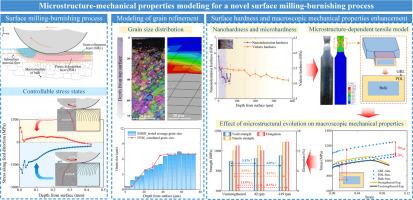Microstructure-mechanical properties modeling for a novel surface milling-burnishing process
IF 9.4
1区 工程技术
Q1 ENGINEERING, MECHANICAL
International Journal of Mechanical Sciences
Pub Date : 2025-09-16
DOI:10.1016/j.ijmecsci.2025.110839
引用次数: 0
Abstract
A novel surface milling-burnishing process (SMBP) was proposed for surface strengthening of metals. The microstructural evolution, nano-hardness, and macro-tensile properties of SMBP-treated Ti-6Al-4V alloy were investigated through experimental and finite element (FE) modeling combined methods. A user-defined subroutine combining JCM-ms plasticity model and modified JMAK dynamic recrystallization model was proposed to predict grain refinement, while the Hall-Petch theory and a nanoindentation hardness-yield strength relationship (HN = 4.6σy) were established to model the surface nanoindentation hardness. The simulated distributions of grain refinement layer (GRL), plastic flow angle, grain size, and nanoindentation hardness exhibit good consistency with the experimental SEM, EBSD, and nanoindentation measurements. The SMBP-treated sample generates an ultrafine-grained surface layer (40–50 µm thick, with grain size <1 µm), achieving a peak hardness of 5.8 GPa which is 38 % higher than that of untreated material. SMBP enables active control of stress states (tension or compression) along the feed-direction through tool movement, while normal-direction stress states remain consistent with varying speeds. Moreover, microstructure-dependent FE simulations of tensile testing were proposed. The microstructural evolution in both GRL and plastic deformation layer (PDL) enhanced the macro-tensile strength of SMBP-treated samples through combined grain refinement and dislocation strengthening mechanisms. Compared to the unstrengthened sample, SMBP-treated specimens exhibited 6.1 %, 8.1 %, and 8.1 % improvements in tensile strength, yield strength, and elongation, respectively. This work establishes a novel SMBP for surface strengthening of Ti-6Al-4V alloy, along with a novel theoretical modeling approach for predicting microstructure and mechanical behaviors.

一种新型表面铣削-抛光工艺的微观组织-力学性能建模
提出了一种用于金属表面强化的表面铣削-抛光新工艺。采用实验和有限元模拟相结合的方法研究了smbp处理后Ti-6Al-4V合金的显微组织演变、纳米硬度和宏观拉伸性能。采用JCM-ms塑性模型和修正的JMAK动态再结晶模型相结合的自定义子程序预测晶粒细化,建立了Hall-Petch理论和纳米压痕硬度-屈服强度关系(HN = 4.6σy)来模拟表面纳米压痕硬度。模拟的晶粒细化层(GRL)、塑性流动角、晶粒尺寸和纳米压痕硬度分布与实验SEM、EBSD和纳米压痕测量值具有良好的一致性。经过smbp处理的样品形成了超细晶表面层(40-50µm厚,晶粒尺寸为1µm),峰值硬度为5.8 GPa,比未处理的材料高38%。SMBP可以通过刀具运动主动控制进给方向的应力状态(拉伸或压缩),而法向应力状态随速度的变化保持一致。此外,还提出了基于微观结构的拉伸试验有限元模拟方法。GRL和塑性变形层(PDL)的微观组织演变均通过晶粒细化和位错强化相结合的机制提高了smbp处理样品的宏观抗拉强度。与未强化的样品相比,smbp处理的样品在抗拉强度、屈服强度和伸长率方面分别提高了6.1%、8.1%和8.1%。本研究为Ti-6Al-4V合金的表面强化建立了一种新的SMBP,并为预测微观组织和力学行为提供了一种新的理论建模方法。
本文章由计算机程序翻译,如有差异,请以英文原文为准。
求助全文
约1分钟内获得全文
求助全文
来源期刊

International Journal of Mechanical Sciences
工程技术-工程:机械
CiteScore
12.80
自引率
17.80%
发文量
769
审稿时长
19 days
期刊介绍:
The International Journal of Mechanical Sciences (IJMS) serves as a global platform for the publication and dissemination of original research that contributes to a deeper scientific understanding of the fundamental disciplines within mechanical, civil, and material engineering.
The primary focus of IJMS is to showcase innovative and ground-breaking work that utilizes analytical and computational modeling techniques, such as Finite Element Method (FEM), Boundary Element Method (BEM), and mesh-free methods, among others. These modeling methods are applied to diverse fields including rigid-body mechanics (e.g., dynamics, vibration, stability), structural mechanics, metal forming, advanced materials (e.g., metals, composites, cellular, smart) behavior and applications, impact mechanics, strain localization, and other nonlinear effects (e.g., large deflections, plasticity, fracture).
Additionally, IJMS covers the realms of fluid mechanics (both external and internal flows), tribology, thermodynamics, and materials processing. These subjects collectively form the core of the journal's content.
In summary, IJMS provides a prestigious platform for researchers to present their original contributions, shedding light on analytical and computational modeling methods in various areas of mechanical engineering, as well as exploring the behavior and application of advanced materials, fluid mechanics, thermodynamics, and materials processing.
 求助内容:
求助内容: 应助结果提醒方式:
应助结果提醒方式:


